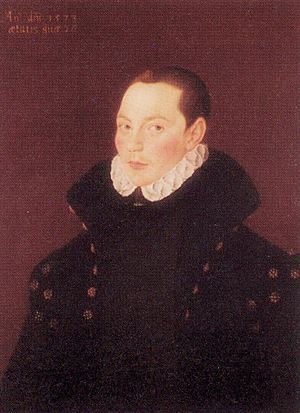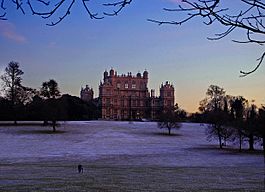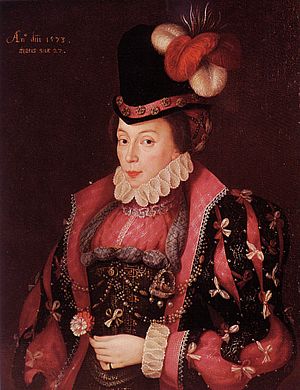Francis Willoughby (1547–1596) facts for kids
Quick facts for kids Sir Francis Willoughby |
|
|---|---|
 |
|
| Portrait of Sir Francis Willoughby, 1573 by George Gower | |
| Spouse(s) | Elizabeth Littleton |
| Father | Sir Henry Willoughby |
| Mother | Anne Grey |
| Born | 1547 Woodlands, Dorset |
| Died | 1596 London |
| Burial | St Giles |

Sir Francis Willoughby (born 1546 or 1547, died 1596) was an important English businessman. He owned coal mines and built the amazing Wollaton Hall in Nottinghamshire. He was known for his efforts to grow his family's wealth and influence.
Contents
Willoughby Family History
Francis Willoughby was the younger son of Sir Henry Willoughby. His father was from Wollaton, Nottinghamshire. Sir Henry died in 1549 during a rebellion. Francis's mother was Anne Grey. She was the daughter of a powerful nobleman, Thomas Grey.
Francis had an older brother named Thomas and a sister named Margaret. His family was very well-connected. His great-grandmother, Cecily Bonville, was one of the richest women in England. His great-great-grandmother was even Elizabeth Woodville, a Queen of England!
Sir Francis Willoughby's Life and Work

Francis's father, Sir Henry, inherited Wollaton and its valuable coal mines in 1549. But just a few months later, Sir Henry was killed during Kett's Rebellion. This was a time of unrest in England.
Francis's older brother, Thomas, was only eight years old then. He became a ward, meaning someone else looked after him. Francis, who was just two, and his sister Margaret were also cared for by family members.
Inheriting the Estate
In 1559, Francis's brother Thomas died while hunting. This meant that Francis, at just 12 years old, inherited the family estates. These included the lands and the important coal mines.
When he was 17, Francis married Elizabeth Littleton. Their marriage was often difficult. They had several daughters, but no sons who lived to inherit the estate.
Building Wollaton Hall
Francis Willoughby greatly expanded the coal mines on his land at Wollaton. This business helped him become very wealthy. He used his money to live a grand lifestyle. He also hired many people to work for him.
He hired a famous architect named Robert Smythson. Smythson had worked on other large houses like Longleat. Together, they built the magnificent Wollaton Hall. It is a grand mansion that still stands today.
Business Ventures and Challenges
Francis Willoughby also tried other business ideas. He invested in growing and processing woad, a plant used to make blue dye. He also put money into a plantation in Ireland.
He owned ironworks in different places. These businesses made money, but Francis also had many debts. He needed to provide money for his daughters' marriages.
In 1595, he handed over some of his businesses to a distant relative, Percival Willoughby. This was done to help pay off some of his debts. Francis died just fifteen months later in 1596. Percival then inherited the estate, along with its many debts.

